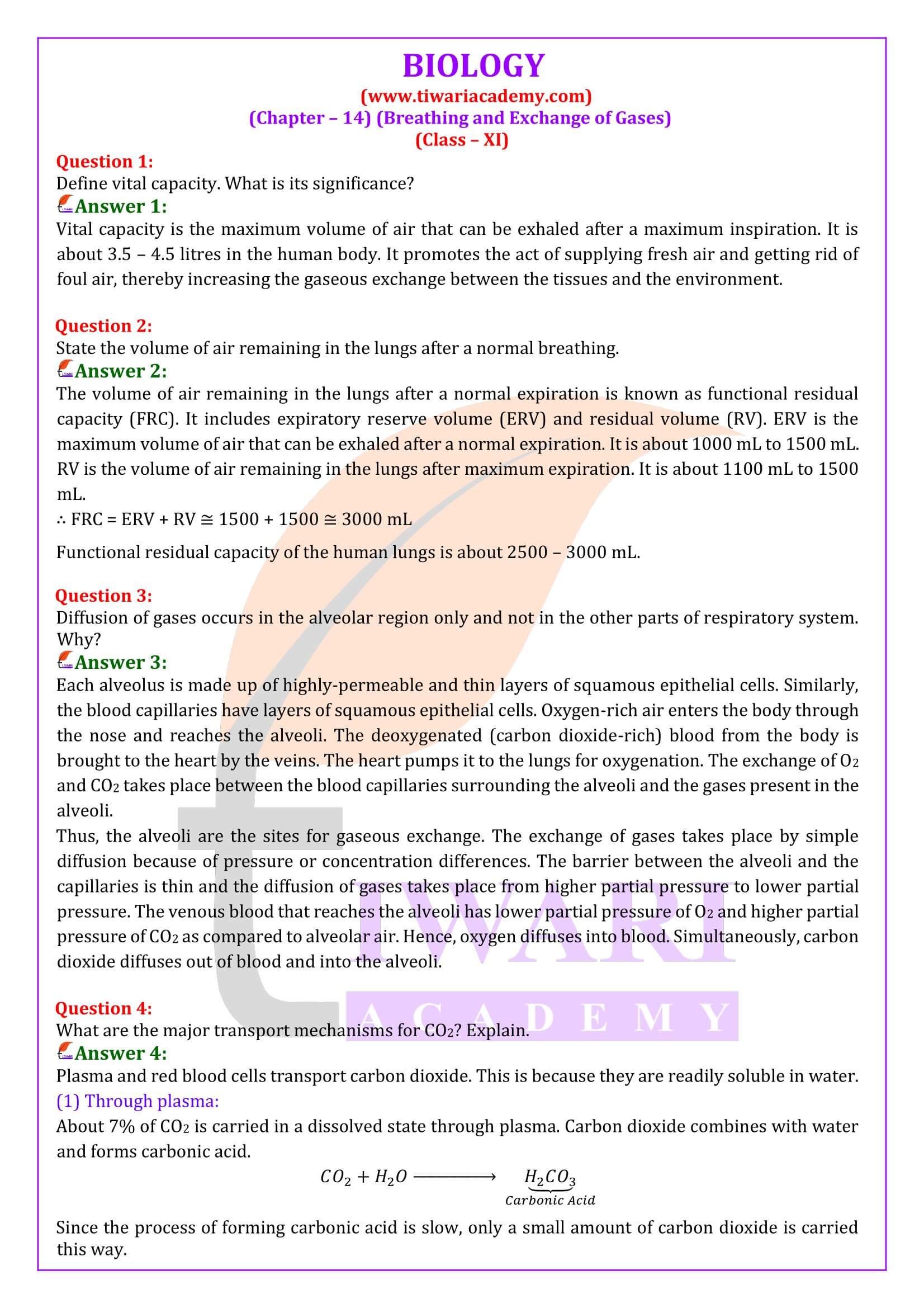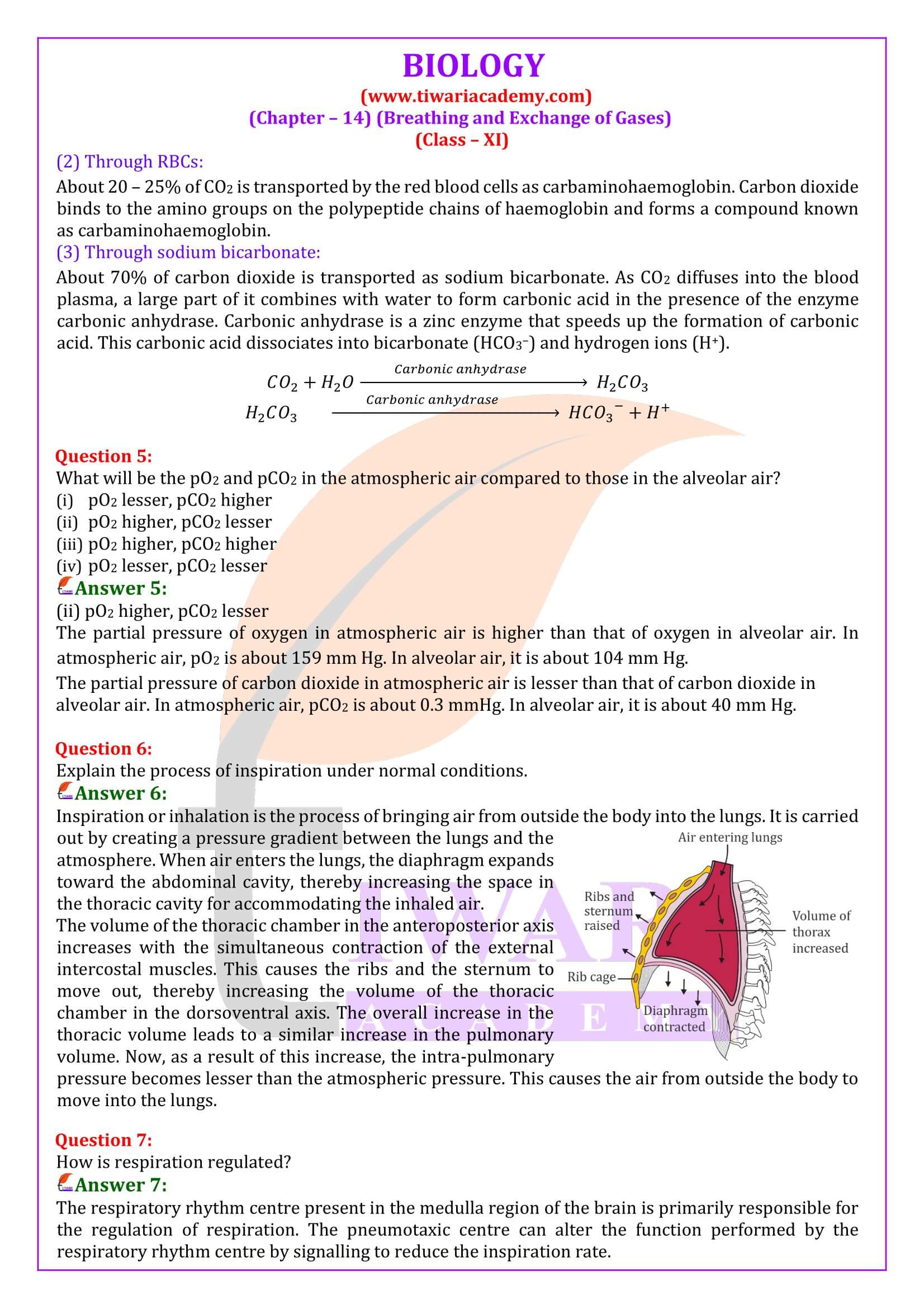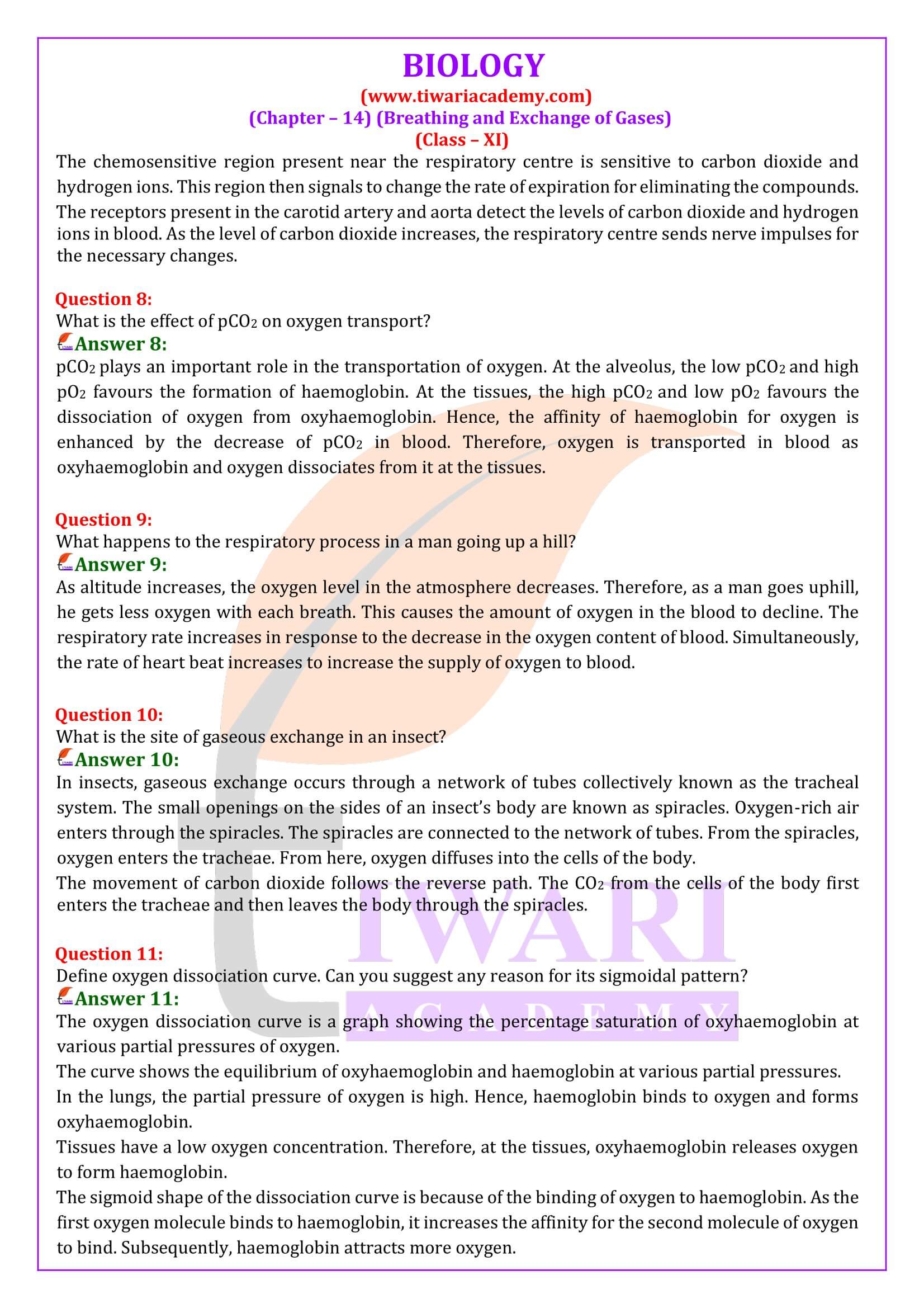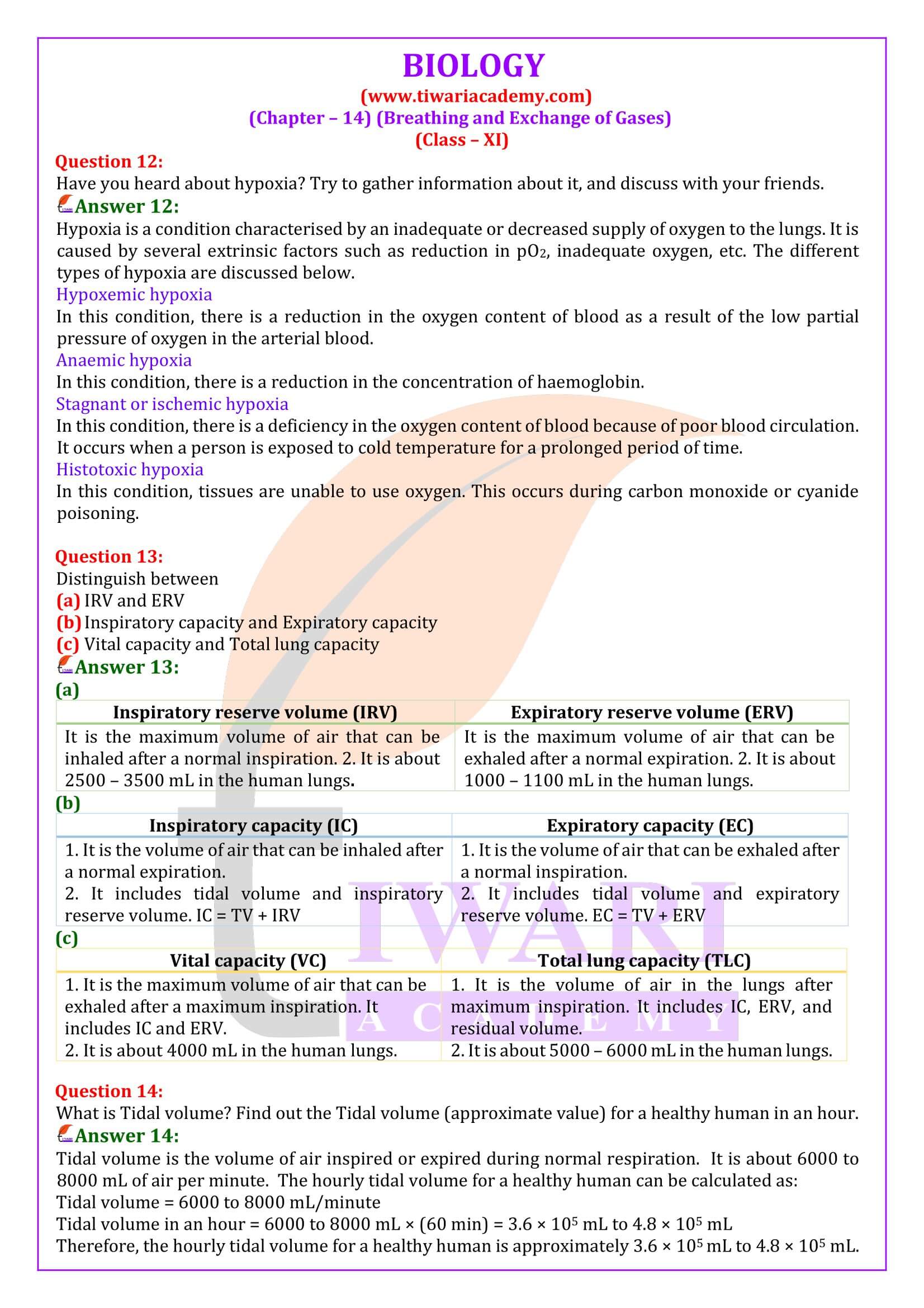NCERT Solutions for Class 11 Biology Chapter 14 Breathing and Exchange of Gases in Hindi and English Medium not only to Study online but also download in PDF format free updated for new academic session 2025-26. Download NCERT Solutions based on latest NCERT Books 2025-26 for CBSE, UP Board, MP Board and all other boards who are using NCERT books 2025-26 as course books. Download Offline Apps and Expression your views through Discussion Forum.
NCERT Solutions for Class 11 Biology Chapter 14
Class 11 Biology Chapter 14 Breathing and Exchange of Gases Solutions
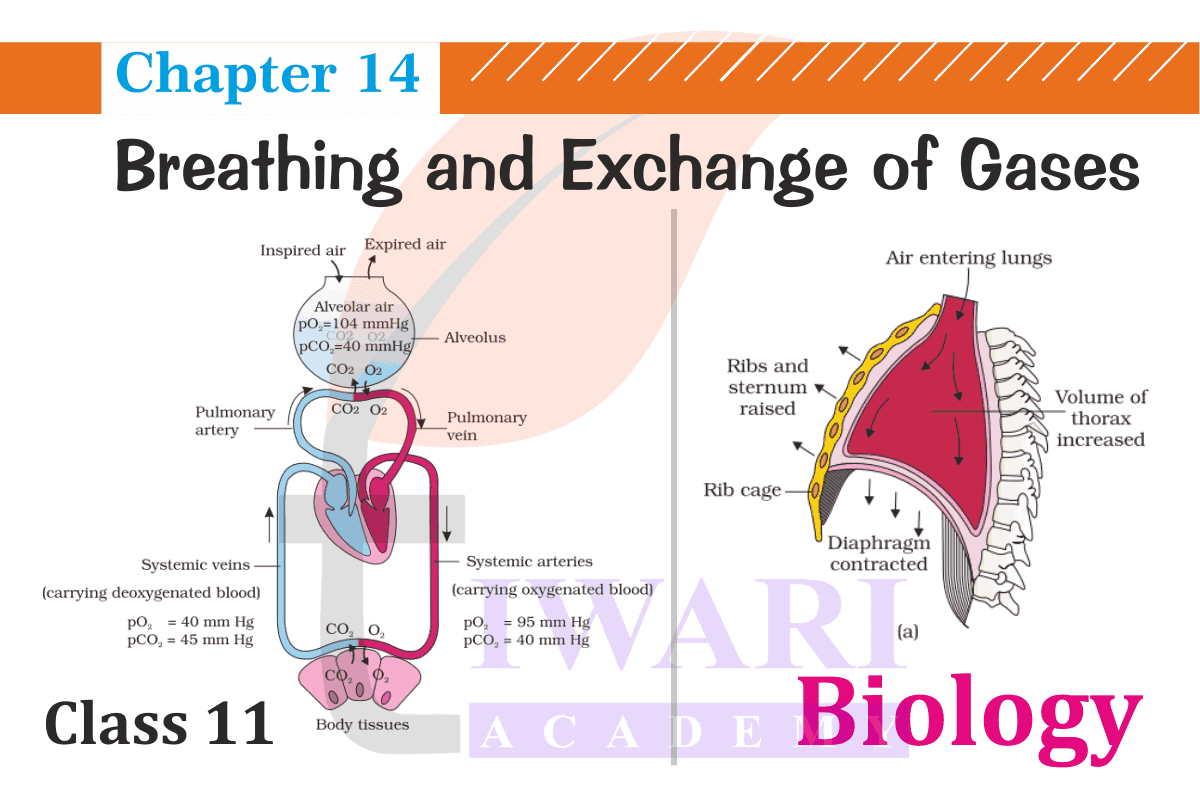
| Class: 11 | Biology |
| Chapter 14: | Breathing and Exchange of Gases |
| Content: | NCERT Exercises and Extra Question Answers |
| Mode of Study Material: | Images and PDF format |
| Session: | Academic Year 2025-26 |
| Medium: | English and Hindi Medium |
Class 11 Biology Chapter 14 Solutions in English
NCERT Solutions for Class 11 Biology Chapter 14 in PDF format free download or view online for new academic session 2025-26. Download NCERT Books 2025-26 and Offline Apps based on latest CBSE Syllabus. NCERT Solutions 2025-26 are helpful for NIOS Study also. If you have any doubt regarding to educational facts, please visit to discussion forum ask your questions.
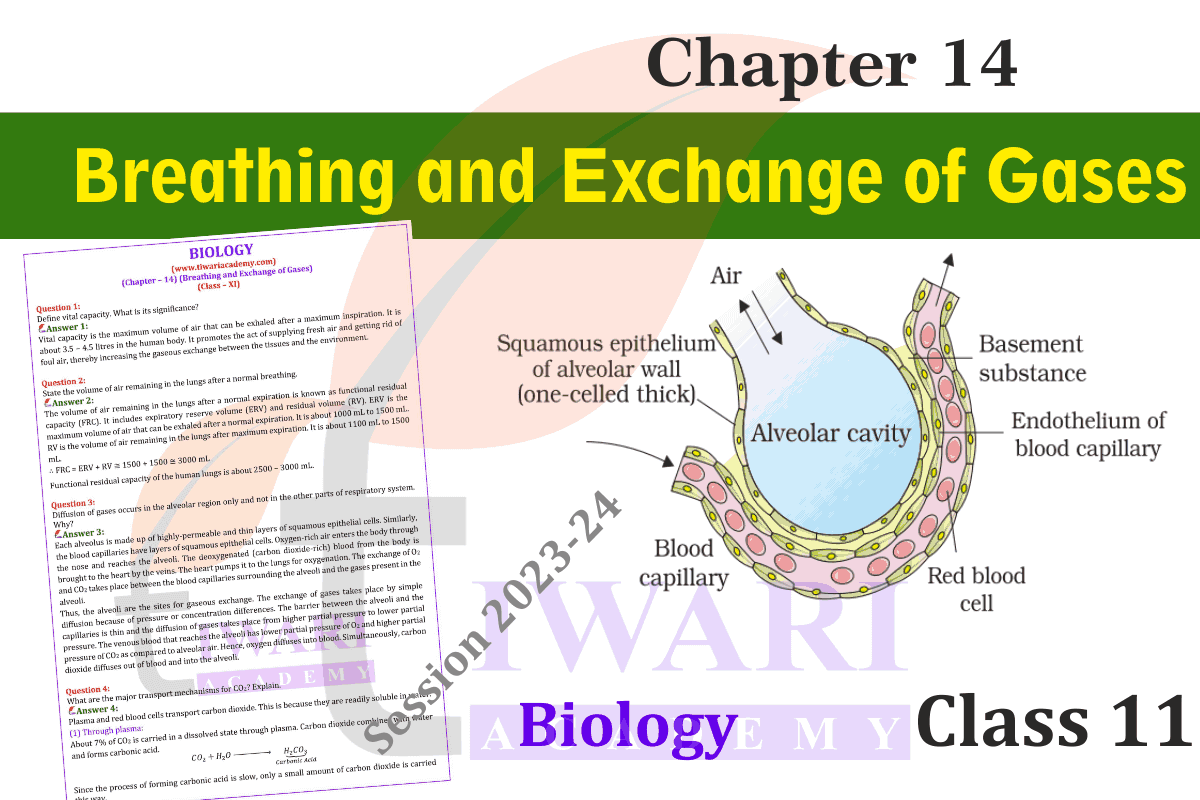
Important Notes on Breathing and Exchange of Gases
1. Breathing (External respiration): The process of exchange of O2 from the atmosphere with CO2 produced by the cells.
2. Carbamino haemoglobin: Compound formed in RBCs when CO2 combine with haemoglobin.
3. Inspiration: Oxygen from fresh air taken by lungs and diffuses into the blood.
4. Diaphragm: A muscular, membranous partition separating the thoracic cavity from the abdominal cavity.
5. Expiration: CO2 given up by venous blood in the lungs is sent out to exterior.
6. Respiration: The sum total of physical and chemical processes by which oxygen and carbohydrates (main food nutrient) etc. are assimilated into the system and the oxidation products like carbon dioxide and water are given off.
HYPOXIA-SHORTAGE OF OXYGEN IN TISSUES.
1. Partial Pressure-The pressure contributed by an individual gas in a mixture of gases. It is represented as pO2 for oxygen and pCO2 for carbon dioxide.
2. Pharynx: The tube or cavity which connects the mouth and nasal passages with oesophagus. It has three parts.
i). Nasopharynx (anterior part)
ii). Oropharynx (middle part) and
iii). Laryngopharynx (posterior part which continues to larynx)
3. Adam’s Apple: The projection formed by the thyroid cartilage and surrounds the larynx at the front of the neck.
4. Tidal volume (TV): volume of air during normal respiration (500 mL)
5. Inspiratory Reserve Volume (IRV): Additional volume of air inspired by a forcible inspiration. 2500mL to 3000mL.
6. Expiratory Reserve Volume (ERV): Additional volume of air, a person can expire by a forcible expiration.
Important Questions on 11th Biology Chapter 14
Define vital capacity. What is its significance?
Vital capacity is the maximum volume of air that can be exhaled after a maximum inspiration. It is about 3.5 – 4.5 litres in the human body. It promotes the act of supplying fresh air and getting rid of foul air, thereby increasing the gaseous exchange between the tissues and the environment.
State the volume of air remaining in the lungs after a normal breathing.
The volume of air remaining in the lungs after a normal expiration is known as functional residual capacity (FRC). It includes expiratory reserve volume (ERV) and residual volume (RV). ERV is the maximum volume of air that can be exhaled after a normal expiration. It is about 1000 mL to 1500 mL. RV is the volume of air remaining in the lungs after maximum expiration. It is about 1100 mL to 1500 mL. ∴ FRC = ERV + RV ≅ 1500 + 1500 ≅ 3000 mL Functional residual capacity of the human lungs is about 2500 – 3000 mL.
Diffusion of gases occurs in the alveolar region only and not in the other parts of respiratory system. Why?
Each alveolus is made up of highly-permeable and thin layers of squamous epithelial cells. Similarly, the blood capillaries have layers of squamous epithelial cells. Oxygen-rich air enters the body through the nose and reaches the alveoli. The deoxygenated (carbon dioxide-rich) blood from the body is brought to the heart by the veins. The heart pumps it to the lungs for oxygenation. The exchange of O2 and CO2 takes place between the blood capillaries surrounding the alveoli and the gases present in the alveoli. Thus, the alveoli are the sites for gaseous exchange. The exchange of gases takes place by simple diffusion because of pressure or concentration differences. The barrier between the alveoli and the capillaries is thin and the diffusion of gases takes place from higher partial pressure to lower partial pressure. The venous blood that reaches the alveoli has lower partial pressure of O2 and higher partial pressure of CO2 as compared to alveolar air. Hence, oxygen diffuses into blood. Simultaneously, carbon dioxide diffuses out of blood and into the alveoli.
Explain the process of inspiration under normal conditions.
Inspiration or inhalation is the process of bringing air from outside the body into the lungs. It is carried out by creating a pressure gradient between the lungs and the atmosphere. When air enters the lungs, the diaphragm expands toward the abdominal cavity, thereby increasing the space in the thoracic cavity for accommodating the inhaled air. The volume of the thoracic chamber in the anteroposterior axis increases with the simultaneous contraction of the external intercostal muscles. This causes the ribs and the sternum to move out, thereby increasing the volume of the thoracic chamber in the dorsoventral axis. The overall increase in the thoracic volume leads to a similar increase in the pulmonary volume. Now, as a result of this increase, the intra-pulmonary pressure becomes lesser than the atmospheric pressure. This causes the air from outside the body to move into the lungs.
How is respiration regulated?
The respiratory rhythm centre present in the medulla region of the brain is primarily responsible for the regulation of respiration. The pneumotaxic centre can alter the function performed by the respiratory rhythm centre by signalling to reduce the inspiration rate. The chemosensitive region present near the respiratory centre is sensitive to carbon dioxide and hydrogen ions. This region then signals to change the rate of expiration for eliminating the compounds. The receptors present in the carotid artery and aorta detect the levels of carbon dioxide and hydrogen ions in blood. As the level of carbon dioxide increases, the respiratory centre sends nerve impulses for the necessary changes.
What is the effect of pCO2 on oxygen transport?
pCO2 plays an important role in the transportation of oxygen. At the alveolus, the low pCO2 and high pO2 favours the formation of haemoglobin. At the tissues, the high pCO2 and low pO2 favours the dissociation of oxygen from oxyhaemoglobin. Hence, the affinity of haemoglobin for oxygen is enhanced by the decrease of pCO2 in blood. Therefore, oxygen is transported in blood as oxyhaemoglobin and oxygen dissociates from it at the tissues.
What happens to the respiratory process in a man going up a hill?
As altitude increases, the oxygen level in the atmosphere decreases. Therefore, as a man goes uphill, he gets less oxygen with each breath. This causes the amount of oxygen in the blood to decline. The respiratory rate increases in response to the decrease in the oxygen content of blood. Simultaneously, the rate of heart beat increases to increase the supply of oxygen to blood.
What is the site of gaseous exchange in an insect?
In insects, gaseous exchange occurs through a network of tubes collectively known as the tracheal system. The small openings on the sides of an insect’s body are known as spiracles. Oxygen-rich air enters through the spiracles. The spiracles are connected to the network of tubes. From the spiracles, oxygen enters the tracheae. From here, oxygen diffuses into the cells of the body. The movement of carbon dioxide follows the reverse path. The CO2 from the cells of the body first enters the tracheae and then leaves the body through the spiracles.
Define oxygen dissociation curve. Can you suggest any reason for its sigmoidal pattern?
The oxygen dissociation curve is a graph showing the percentage saturation of oxyhaemoglobin at various partial pressures of oxygen. The curve shows the equilibrium of oxyhaemoglobin and haemoglobin at various partial pressures. In the lungs, the partial pressure of oxygen is high. Hence, haemoglobin binds to oxygen and forms oxyhaemoglobin. Tissues have a low oxygen concentration. Therefore, at the tissues, oxyhaemoglobin releases oxygen to form haemoglobin. The sigmoid shape of the dissociation curve is because of the binding of oxygen to haemoglobin. As the first oxygen molecule binds to haemoglobin, it increases the affinity for the second molecule of oxygen to bind. Subsequently, haemoglobin attracts more oxygen.
Have you heard about hypoxia? Try to gather information about it, and discuss with your friends.
Hypoxia is a condition characterised by an inadequate or decreased supply of oxygen to the lungs. It is caused by several extrinsic factors such as reduction in pO2, inadequate oxygen, etc. The different types of hypoxia are discussed below. Hypoxemic hypoxia In this condition, there is a reduction in the oxygen content of blood as a result of the low partial pressure of oxygen in the arterial blood. Anaemic hypoxia In this condition, there is a reduction in the concentration of haemoglobin. Stagnant or ischemic hypoxia In this condition, there is a deficiency in the oxygen content of blood because of poor blood circulation. It occurs when a person is exposed to cold temperature for a prolonged period of time. Histotoxic hypoxia In this condition, tissues are unable to use oxygen. This occurs during carbon monoxide or cyanide poisoning.
What is Tidal volume? Find out the Tidal volume (approximate value) for a healthy human in an hour.
Tidal volume is the volume of air inspired or expired during normal respiration. It is about 6000 to 8000 mL of air per minute. The hourly tidal volume for a healthy human can be calculated as: Tidal volume = 6000 to 8000 mL/minute Tidal volume in an hour = 6000 to 8000 mL × (60 min) = 3.6 × 105 mL to 4.8 × 10^5 mL Therefore, the hourly tidal volume for a healthy human is approximately 3.6 × 10^5 mL to 4.8 × 10^5 mL.
Inspiration
1. If the pressure within the lungs (intrapulmonary pressure) is less than the atmospheric pressure, i.e., there is negative pressure in the lungs with respect to the atmospheric pressure.
2. The contraction of diaphragm increases the volume of thoracic chamber in the antero-posterior axis.
3. The contraction of external intercoastals muscles lifts up the ribs and the sternum causing an increase in the volume of thoracic chamber in the dorso ventral axis.
4. It causes an increase in pulmonary volume decrease the intra-pulmonary pressure to less than the atmospheric pressure.
5. If forces the air out side to move in to the lungs, i.e., inspiration.
